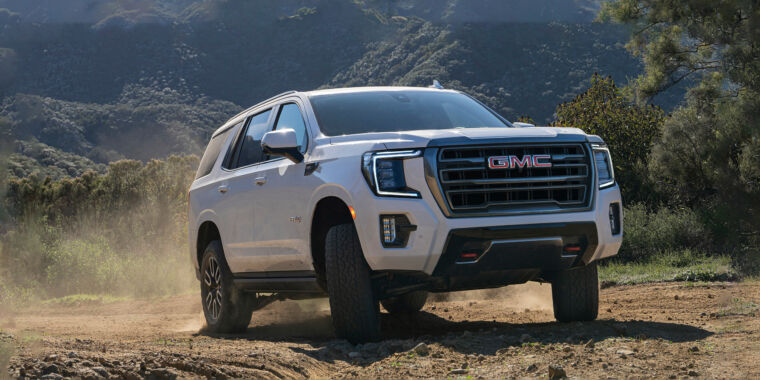Android Automotive goes mainstream: A review of GMs new infotainment system

WebOS lives! — Android Automotive goes mainstream: A review of GMs new infotainment system It has four screens, three operating systems, and many of the usual car problems.
Ron Amadeo – Jan 6, 2023 12:20 pm UTC EnlargeGMC reader comments 217 with 0 posters participating Share this story Share on Facebook Share on Twitter Share on Reddit
Android Automotive, Google’s operating system for cars, has historically been pretty niche, and only a handful of high-profile cars like the Polestar 2 have used it. Now, though, Android Automotive is going mainstream, and we’re starting to see some of the biggest car manufacturers roll out Google’s operating system across entire lineups.
Today, we’re looking at the 2022 GMC Yukon, but really, this is General Motors’ Android Automotive system, and you’ll see it rolled out across most of GM’s lineup in the future. The same basic setup powers the Hummer EV1, and with all of the parts-sharing that goes on at GM, expect to see this system pop up in Chevys, GMCs, Cadillacs, and Buicks. With Ford and Honda jumping into the Android Automotive ecosystem in the near future, Google’s car OS will soon be everywhere.
Let’s get the usual disclaimer out of the way: This article is not about Android Auto, Google’s tethered phone app and competitor to Apple’s CarPlay. Android Automotive, fully spelled out (it’s sometimes branded as “Google Built-In”), means the car is one big Android device. A computer runs the car’s infotainment system, and that computer runs Android. Even if you have an iPhone in your pocket, that won’t change the OS your car runs (it does support CarPlay, though). For most models, buying General Motors will mean buying an Android Car. You’ll see an on-screen message pop up during setup saying, “By using this car, you agree to Google’s terms of service.” This is one of the first screens the car shows from a fresh reset. If you don’t want to agree to Google’s terms of service, call an Uber. Ron Amadeo You don’t get much in the way of privacy options. You’d probably never block apps like Google Maps from using your location. Ron Amadeo
The idea here makes some sort of sense. Consumers want their car infotainment system to look and work more like a smartphone does, so why not just load the vehicle with a smartphone OS? Then you can get all the smooth-scrolling, touchscreen-based swipe navigation that people have come to expect from a modern computer. Android Automotive is a Google-blessed OS, and like phone companies, manufacturers like Ford, GM, and Volvo sign deals with Google to license the OS and a slew of Google apps. This car has onboard Google Maps, probably the biggest killer app in the automotive industry. You also get Google Assistant voice commands and the Google Play Store for cars, allowing easy access to apps like Spotify and other media players. Advertisement The hardware: Four screens, three operating systems Enlarge / The main infotainment screen.Ron Amadeo
Reviewing a car computer is a strange proposition because the hardware is always so old. Car development takes around five years, and when the cars finally get to market, the computer hardware isn’t that exciting. The hardware for our Android Car systemwhich is internally called “General Motors Infotainment 3.7,” or “gminfo37″is a 5-year-old Intel Atom A3960 SoC with an Intel HD Graphics 500 GPU, 6GB of RAM, and 64GB of flash storage.
This is not uniquely a GM problem, and the same CPU exists in the Polestar 2though that system has only 4GB of RAMso we’ll classify both cars as “first-generation Android Automotive hardware.” The age of the hardware is notable, though. Android Automotive doesn’t let you sideload apps into a production car, but look up Atom A3960 Geekbench scores, and you’ll see that the computer in this $78,000 vehicle is barely faster than a $35 Raspberry Pi 4. The GMC Yukon and Polestar 2 both feature one of the slowest CPUs you can buy today in any form factor.
I’m sure the Atom A3960 went through a lengthy certification process to ensure it can survive the heat and vibration of a tough car environment, but it’s disappointing to see GMC shipping what are basically budget PC parts from 2016. Even if the five-year hardware delay is unavoidable, the company could have started with mid-range or high-end 2016 Intel hardware rather than cheap Atom parts. Page: 1 2 3 4 5 6 Next → reader comments 217 with 0 posters participating Share this story Share on Facebook Share on Twitter Share on Reddit Ron Amadeo Ron is the Reviews Editor at Ars Technica, where he specializes in Android OS and Google products. He is always on the hunt for a new gadget and loves to rip things apart to see how they work. Email ron@arstechnica.com // Twitter @RonAmadeo Advertisement Channel Ars Technica ← Previous story Next story → Related Stories Today on Ars


